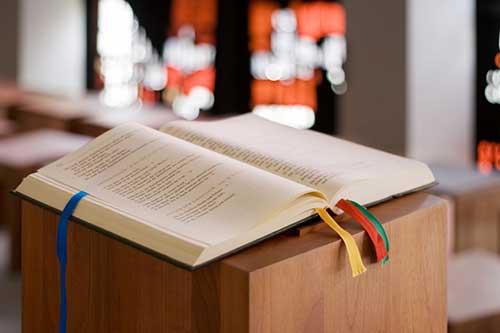
Jesus, we presume, spoke mostly in Aramaic. The original context of his stories and sayings was with Middle Eastern peasants. That was the original location.
After his death, these stories and sayings of his were told and retold in new locations – Greek-speaking communities around the Mediterranean and eastwards into Asia. A new context. Often they were reinterpreted, adapted to apply in this new location.
These well-worn stories and sayings were then collected into documents, into gospels. And to do that meant a decision was made by the gospel author about what order to put them in. They were given a new location – the location within the particular scroll: placed within the context of an event, preceded by other events, strung together thematically with similar concepts and themes. Again, the new location, the location within a larger, written context meant reinterpretation and adaptation.
With the invention of the bound book, a canonical order developed. Mark followed Matthew and preceded Luke. Canonical Criticism, a discipline that came up in a recent post, deals academically with this new location, this new context.
Now for another context – translation.
I’ve already noted the translation from Aramaic to Greek. Inspiration (apparently) covers that change – the Greek words of Jesus are considered inspired (I presume people would say that Jesus’ original Aramaic words were!) But wait, there’s more!! Whilst many/most Christians would say that the Hebrew-language First Testament is inspired, the earliest Christians certainly saw its Greek translation, the Septuagint, as being inspired. That version was quoted in the New Testament.
The creation myth of the origin of the Septuagint has that the 70 (or 72) scholars each translated the Hebrew to Greek independently and then discovered the translations were identical! My point isn’t whether that story is history or not, I want to underscore the understanding that the Greek translation of the First Testament was seen to be inspired.
If the Septuagint is inspired (and at least its use by the inspired New Testament would argue so) then why would the inspiration stop with that translation. Some argue that the translation into English, The King James Bible, is authoritative. The King James Bible holds a particular place, for example, in the formularies binding on my church.
The words have moved from a Middle-Eastern context and location to Seventeenth-Century England.
I have a final location that fascinates me, and around which I would love to do some further thinking and study, and that is the location of the words and stories in the context of liturgical celebrations, in the life of the church’s worship.
In each location I have described, the words may be reapplied in a way that those in the previous location had no inkling about. Jesus used them in one context, they were retold and re-appropriated in quite different contexts, then they were written up to be part of the new context of an ongoing written gospel narrative, then translated into a variety of languages in a Medieval and Modern context, and often re-suited into a liturgical location or crowbarred into theological debates.
Many of us might have experienced this last Sunday. The Gospel reading, Matthew 25:31-46 had it’s original location in the teaching of Jesus. Or not. In the book, The Five Gospels: What Did Jesus Really Say? The Search for the Authentic Words of Jesus Paperback – December 19, 1996 by Robert W. Funk, this story (Matthew 25:31-46) is categorised “black”. Scholars of The Jesus Seminar voted using four colours and then the colours were averaged. Black beads indicated the voter believed Jesus did not say the passage. In the case of this particular passage, those scholars say it comes from later admirers or a different tradition.
Whether you hold to it coming from the mouth of the historical Jesus or not, unless you are going to argue this story is completely the invention of Matthew, the story was repeated as part of the early life of the Church (new location), and then was recorded in a particular place in Matthew’s Gospel, fitting in with the particular way that he wanted his document to progress (another location).
At this stage, still, it seems that the focus of this particular story is on how people (the non-church) were treating members of the Church – the least of these brothers [and sisters] of “the king” (τῶν ἀδελφῶν μου τῶν ἐλαχίστων). This is a judgment story about the non-church – “all the nations” (πάντα τὰ ἔθνη).
Jesus identifies with his disciples: “just as you did it to one of the least of these who are members of my family, you did it to me”. It is not a story about how Christians treat others. It is a story about how “the nations” treat Christians.
In discussions I have been following, some get irked by this pointing to the original location. They look at the translation (a further location, you understand) and say, but look, it says: “and he will separate people one from another”. The Greek, of course, simply says “he will separate them (αὐτοὺς)”. The King James Version has it right:
And before him shall be gathered all nations: and he shall separate them one from another, as a shepherd divideth his sheep from the goats
Understanding “nations” in a contemporary usage, of course, is another shift in location and context. And that is where some of the other locations take us: into our present translations and contexts, where we may move away from Jesus’ intent, through Matthew’s authorial intent, to its interpretation over the centuries, and its location in our liturgical usage where many (most?) have used it to have God challenging all of us in the way we treat those who are less well off.
Some of this, many of you will have noticed, is what I address, week by week, in my introduction to the lectionary readings.
Others may also notice that this post is dabbling in literary theory and applying different aspects to the Bible, its inspiration and explanation. To stay with last Sunday’s gospel reading, some will have approached it from the perspective of authorial intent, attempting to reconstruct the intent of Jesus, the earliest church, and Matthew in telling the story. These will have seen that the story is about how “the nations” treat Christians.
Others will have been more at the reader response critics end of the spectrum, assuming or even arguing that the author’s intent itself is immaterial and cannot be fully recovered. It is the reader’s impression of the author’s intent that is at work – including in the action of translation. And then, the reader (or hearer) is further affected by the location of the text in worship and the life of the church. To conclude with a final reference to our example, this is when the Matthew 25 gospel story is applied to all of us in the way we treat the hungry, the thirsty, strangers, those naked, sick, or in prison.
If you appreciated this post, consider liking the liturgy facebook page, using the RSS feed, and/or signing up for a not-very-often email, …




I have heard this argument before: that the text is about how others treat Christians, but I have never understood how that actually follows from the text and I am unfortunately no clearer from your explanation either Bosco.
It does not seem to make sense that one nation is separated from another nation on the basis of how that nation treated Christians. Surely, if one accepts this understanding, the “them” pertains to individual members of the various nations and how they treated Christians ?
I do not think that the Church gives us this text to encourage us to reflect on how the nations treat us Christians, at least not in the local context, but to encourage us to reflect on how we treat the real presence of Christ in the poor and suffering.
Many Blessings
Thanks, Chris. Working backwards from your final paragraph, that is the approach I was suggesting from the liturgical and English-translation (eg NRSV) location. I wonder if you are projecting the contemporary understanding of “nation states” back onto τὰ ἔθνη? But, I can also see your point – I often find this when you press a parable (or allegory) too hard. It doesn’t all hold together neatly. Blessings.
Bosco, I really loved this blog post (of course, I always enjoy your writing). It took me many decades to arrive at a place where I understood the value of all of these different “locations” you describe. It is actually now enjoyable for me to position texts in different times and contexts and to evaluate them in light of where Jesus stood in his time, place, and culture. Most helpful for me is non-dualistic thinking — embracing that god’s truth is not as non-binary as I may have believed in my youth.
Thanks for the encouragement, Jonathan. Did you mean binary rather than non-binary in your last sentence? Blessings.
The popular phrase ‘the living word’ comes to mind; it does not appear as such in the Bible does it? But the discussion keeps the Word alive and we make our choices within the faith based on what we determine from it. Logos.
I grew up with a lot of refined images of Jesus because of English earlier history- he was no longer a Jew because of anti-semitism, he was white because black people were not yet leaders in our culture, he spoke in the language of a sixteenth century courtier.
Many times I have been told a certain phrase means a definite particular interpretation when clearly several interpretations are possible depending on the layer of thought, via as you say the society, the translation, the allegory and spoken rather than written tradition etc.
The mythology: a word which enthralls some, appalls others, maybe because interpretation is the most deeply embedded in the individual personality of the follower!
It seems to me that the social location of this verse, the poor and persecuted, would have been the community of Jesus, and later Matthew. That is still the case in many countries where Christians are poor and/or persecuted today. But not in countries like New Zealand, where the application must necessarily differ.
Many blessings
I think that is helpful, thanks, Chris. And fits well within the shift of translating the author’s original intention into our new location. Blessings.